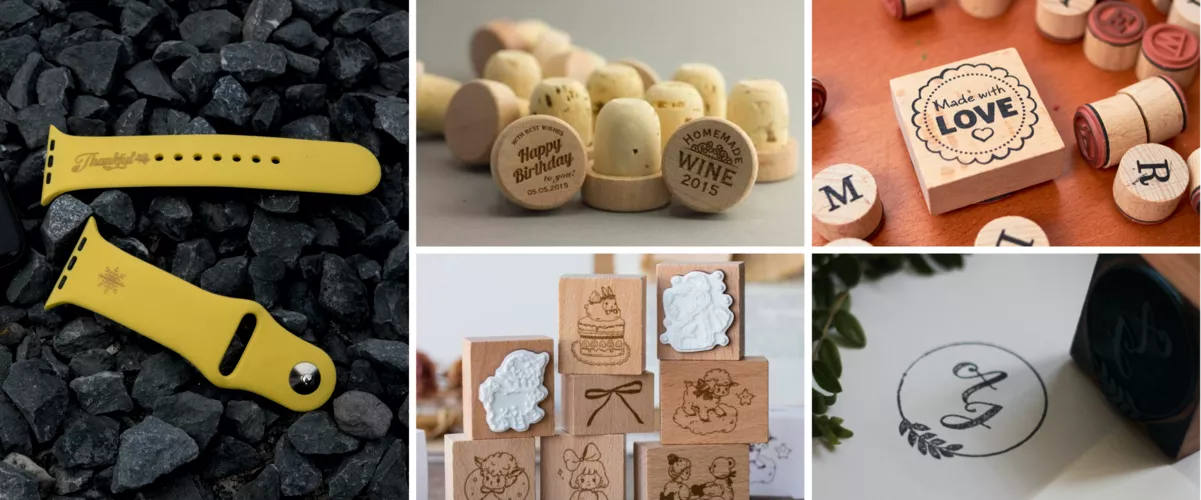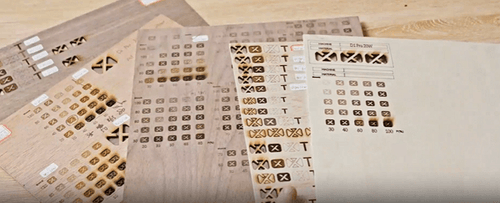The Complete Laser Cutting Materials List

Laser cutters give you a variety of options to create custom items. Despite being called laser cutters, they are used to cut, engrave, and mark various materials. While you might often see laser cutters being used on wood, this isn’t the only material they can handle. In fact, there are numerous laser cutter materials.
However, not all laser cutters are created equal, different types of laser machines are suited for different materials. It’s crucial to ensure that the laser cutter you choose is compatible with your desired materials. And materials respond differently to lasers; while some are safe and process well, others might release toxic fumes or melt under the laser's heat. Therefore, it’s important to identify the right materials for laser cutting.
In this guide on laser cutting materials, we'll explore which materials are laser-friendly and the appropriate laser machines to handle them. Moreover, we will provide some tips to help you achieve excellent results on your laser cutting projects with the materials.
In This Article
- What Materials Can be Cut Using a Laser Cutter
- What Materials Should Not be Cut or Engrave with a Laser Cutter?
- Laser Types for Different Materials
- Laser Cutter Settings for Different Materials
- Laser Cutting With xTool P2
- FAQs on Laser Cutting Materials
What Materials Can be Cut Using a Laser Cutter
Laser cutting is a subtractive manufacturing technology that uses a high-power laser beam to melt, burn, or vaporize the material.
The process begins with a design file loaded into the laser cutter software. As the machine starts, the laser cutter moves the beam along the design file’s path as instructed by the software to ensure accuracy and repeatability.
The high-intensity laser beam from the laser heats the material, and the designated areas are either melted, burned away, or vaporized, leaving precise and clean cuts.

The beauty of laser cutting lies in its adaptability. The laser cutter settings—like the laser's power, speed, and duration—are adjustable, making it possible to cut a variety of materials, including wood, acrylic, leather, fabrics, rubber, paper, and metal, with clean and polished cuts.
Typically, if the laser cutter can cut a material, it can also engrave it.
1. Wood for Laser Cutting

Wood is one of the most popular laser cutter materials. It has a natural and warm appearance that can suit many laser cutting projects, such as signs, ornaments, jewelry, toys, puzzles, and more. Wood can be cut in various thicknesses and shapes, depending on the power and speed of the laser.
There are different types of wood that can be used for laser cutting and engraving, including natural wood, plywood, and MDF.
However, wood is a flammable material and can produce some unexpected burn marks and charred edges. To avoid this problem, you’ll need to adjust the laser power and speed settings, use masking tape, air assist, and a honeycomb table. You can check out this detailed guide on how to avoid burn marks when laser cutting wood.
RELATED: Laser cutting plywood

XTOOL S1
Best Desktop Diode Laser Cutter
Easy and safe for home use. Ideal choice for both DIY and Business Projects.
Learn More2. Plastic and Acrylic for Laser Cutting

Plastic is also a common material for laser cutting and engraving. They are synthetic materials that come in various colors, thicknesses, and finishes. They can be cut with a smooth edge and a glossy surface by a laser.
Acrylic or plexiglass, is the most popular plastic for laser cutting. By laser cutting acrylic, especially clear ones, you can create beautiful glass-style artwork, such as ornaments, signs, displays, jewelry, and wall art.
However, not all plastics are suitable for laser cutting. Some plastics may contain chlorine or other harmful substances that can produce toxic fumes when heated by the laser. Therefore, it is important to check the composition of the plastic before cutting it with a laser. And always maintain a good ventilation when laser cutting plastics.
RELATED: Laser cutting plastic
3. Metal for Laser Cutting

Using a laser for cutting metal can be a bit tricky. You will need specific laser types for this purpose. However, laser engravers work extremely well for engraving metal. Metal is a great laser engraver material that allows you to make a wide array of personalized items or engraved gifts.

XTOOL F1 ULTRA
Best Desktop Fiber Laser Cutter
It features a powerful 20W fiber laser that allows you to engrave and cut metal.
Learn More4. Leather for Laser Cutting

Once you’ve practiced a bit with other laser cutting materials and laser engraving materials, you might want to try your hand at leather. It’s an expensive material, but the results look amazing. You can create wallets, belts, purses, jewelry (especially bracelets) , keychains and more. You can refer to the laser engraving leather and laser cutting leather guide to get the best practice with processing leather materials using a laser cutter.
5. Cardboard for Laser Cutting

Cardboard is one of the most inexpensive and easiest laser cutting materials to work with. Model-building pieces are one of the most common laser cut cardboard projects. Typically, you can choose between corrugated, gray and cellulose cardboard.
6. Fabric for Laser Cutting

Fabric is a newer option for laser cutting materials. Laser cutting and engraving fabric works as a form of digital embroidery. You get similar results in a lot less time. While leather is obviously one type of textile, cotton, nylon, polyester, and silk are all options too.
7. Paper for Laser Cutting

In most cases, when laser cutting paper, you’ll likely be cutting cardboard. However, thick cardstock paper is also excellent material for laser cutting. A creative project to try with paper is custom cards with a laser-cut center scene. These are beautiful and make great gifts.
8. Rubber for Laser Cutting

Rubber is another laser engraving material that can be cut or engraved using a laser machine. Though it is a widely used material for various purposes but is not very common in laser cutting. But with a laser, you can use it for making stamps, keychains, mats, personalized apple watch bands and other items that require rubber.
Laser is the right option for rubber cutting because it offers fine and perfect cutting results. The edges are smooth and perfect, which cannot be achieved by any other method. It can cut various types of rubber, including natural rubber, silicone rubber, and synthetic rubber. However, you need to make sure proper ventilation because of the fumes produced during laser cutting.
RELATED: Laser cutting and engraving rubber
9. Glass for Laser Cutting

Due to its fragile nature, glass is prone to cracking when laser cut. However, glass can still be laser cut using specific laser types. Moreover, when laser engraved, glass is imprinted with beautiful frosted pattern, making it a good laser engraving material for making a variety of decorative items.
RELATED: Laser engraving glass
What Materials Should Not be Cut or Engraved with a Laser Cutter?
Undoubtedly, laser cutters can cut and engrave a wide range of materials. But there are some materials that you should never try cutting and engraving using a laser. Avoid these materials because they can catch fire and produce harmful gasses/smoke.
1. PVC
PVC stands for Poly Vinyl Chloride. It is a polymer that produces chlorine gas when exposed to a laser. First of all, the gas is irritating, which causes irritation and burn in your eyes, nose, skin, and respiratory tract. Secondly, the nature of the gas is corrosive. It can harm the frame of the machine, which is made of metal. It can also harm the laser as well as other parts of the machine. Thus, if you want to use the machine for a long time and keep yourself safe, you should never cut or engrave PVC.
RELATED: Can you laser cut vinyl? Is it safe?
2. Polycarbonate
Polycarbonate tends to discolor when heated by the laser. Besides, it's prone to catching fire.
3. Polystyrene and Polypropylene Foam
These are two types of foams, and both are not suitable for laser cutting. Firstly, they catch fire quickly, and when you try to cut them using a laser machine, they only melt; no cutting at all.
4. HDPE
You cannot cut it with a laser because it melts and gets gooey when exposed to a laser. Secondly, it can also catch fire.
5. Coated Carbon Fiber
If the carbon fiber is coated, then its coating can release various toxic gasses when laser cut. These fumes are very harmful and can lead to respiratory diseases.
6. Galvanized Metal
Galvanized metal is coated with a layer of zinc to prevent rusting. When a laser beam comes into contact with galvanized metal, it heats the zinc coating and can vaporize it. This process releases zinc oxide fumes into the air. Zinc oxide is hazardous to human health. Ensuring the health and safety of operators is paramount, hence materials that can release toxic fumes like zinc oxide are not suitable for laser processing.
Similar to galvanized metals, products treated with galvanized compound sprays also pose risks when subjected to laser processing. These sprays often contain zinc or other potentially hazardous substances that can release toxic fumes when heated by a laser.
Laser Types for Different Materials
Laser cutters and engravers work by using a high-powered laser beam of light to vaporize the materials. In laser engraving, a shallow layer of material is removed from its surface, leaving a permanent mark. In laser cutting, the laser penetrates the material, cutting it into desired shapes.
To be engraved or cut, the material needs to absorb the light to obtain the heat, which means the laser light won't be reflected by the material or pass through the material. This is influenced by the wavelengh of the laser. Thus, the materials a laser can cut and engrave depend on the wavelength of the laser as well as the material's optical properties. Materials that have a high absorption rate for the specific laser wavelength are ideal for laser cutting and engraving.
What Materials Can You Cut with a CO2 Laser Cutter?
For cutting and engraving non-metal materials, CO2 laser cutters are the best options. These lasers produce a wavelength of around 10.6 micrometers. This wavelength is well absorbed by non-metal materials, making CO2 lasers an excellent choice for cutting and engraving materials like wood, plastic, acrylic, leather, paper, fabric, and rubber.
CO2 laser cutters are also suitable for engraving on certain types of coated and anodized metals.
What Materials Can You Cut with a Didoe Laser Cutter?
Diode laser cutters are also an ideal option for cutting and engraving non-metals. Their wavelength is around 455nm~1064nm. But they have some material limitations compared with CO2 lasers. Expecially for the tranparent materials such as clear acrylic and glass, you need to apply a coating to them before engraving them using a diode laser, however diode lasers cannot cut clear materials.
What Materials Can You Cut with a Fiber Laser Cutter?
For metal materials, fiber lasers are the best option. Unlike CO2 lasers and diode lasers, fiber lasers can both engrave and cut metals directly.

Additionally, infrared lasers are also an ideal option for engraving metal.
Remember, the suitability of lasers also depends on the thickness and density of the material.
Laser Cutter Settings for Different Materials
If you want perfect results from your laser machines, you need to choose the optimal settings. Otherwise, the laser won’t offer the result you need. If the power is too high or the speed is too low, it might burn the material. On the other hand, if the power is too low, the machine won’t be able to cut. Thus, choosing the right settings is essential.
There is no hard and fast rule or exact numbers that you can use for different laser engravable materials. The settings depend on the optical power of the laser machine. The best way to know the right settings is by running a power-speed test. It will give you a better idea of the settings, then you can choose the best one.

xTool has created a detailed list of power and speed settings for different materials. You can check the values in the material settings list and give it a try.
Laser Cutting With xTool P2
When it comes to laser cutting, the right equipment can make all the difference in achieving high-quality results. One such piece of equipment is the xTool P2, a powerful CO2 laser cutter, which is known for its versatility and precision in cutting a wide range of materials.

With its high power of 55W and 0.01mm precision, this laser cutter is particularly well-suited for cutting thicker materials like acrylic, wood, leather, paper, fabric. Its powerful laser beam is capable of cutting through 20mm acrylic and 18mm plywood in one pass. On top of that, it can reach a maximum engraving speed of 600mm/s, making it a popular choice for both hobbyists and businesses alike.
Additionally, this laser cutter is equipped with a range of features that make it easy to use and control. Its two built-in 16MP cameras allow for precise and easy positioning, while its air assist system and exhaust fan system help to blow away debris and fumes, keeping the laser lens clean and ensuring better cutting and engraving results and a safe working area.
One of the standout features of this CO2 laser cutter is its ability to perform rotary engraving. This allows cylindrical objects like tumblers, wine glasses, and pens to be engraved with ease, opening up a world of possibilities for personalized gifts and promotional items. But the versatility of this laser cutter doesn't stop there. This machine can also support curved engraving.
And with its 600*305mm working area, which can be further extended with its passthrough feature and riser base, it allows for larger materials processing.

Overall, the xTool P2 is a great investment for businesses that need a versatile, precise, and efficient machine for laser cutting various materials.
FAQs on Laser Cutting Materials
What is the Thickest Material a Laser Cutter Can Cut?
It depends on the type and power of the laser cutter. Different types of lasers have different capabilities and limitations when it comes to cutting materials.
Generally speaking, fiber lasers are the best choice for cutting metals, while CO2 lasers are more suitable for cutting non-metals.
The power of the laser cutter also determines the maximum cutting thickness. Higher power lasers can cut through thicker materials, while lower power lasers are limited to thinner materials.
For example, xTool P2(55W CO2 laser cutter) can cut 20mm acrylic in one pass.
What Materials Can a 10W Laser Cut?
A 10W laser is a low-power laser that can only cut thin sheets of some materials, such as wood, paper, leather, felt, and acrylic, such as xTool D1 Pro 10W.
Conclusion
A laser machine is capable of cutting a wide range of materials. We have discussed some of the common materials that can be cut using a laser, so you can pick these materials confidently for your projects. We hope this article will make picking the right material and its optimal settings easier.


